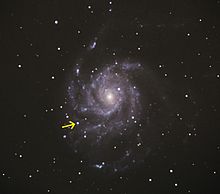SN 2011fe
SN 2011fe is a Type Ia supernova that was discovered in M101 in August 2011 . It is located around 21 million light years from Earth. So far, it is the type Ia supernova discovered at the earliest stage of its development.
discovery
The star explosion was discovered as part of the large-scale, fully automated Palomar Transient Factory (PTF) survey on August 24, 2011 on recordings from the nights of August 22 and 23 and was initially named PTF 11kly . When it was discovered, the supernova had an apparent magnitude of 17.2 mag. On September 4, the apparent magnitude was 10.3 mag, probably near the maximum. Upon discovery, it was expected that the brightness could increase by 6 mag.
meaning
Type Ia supernovae occur when in a narrow binary system a CO white dwarf accretes matter from a companion star, until finally the degeneracy pressure of the electrons is not sufficient to stabilize the white dwarf and this begins to collapse (it exceeds the Chandrasekhar- Limit ). As a result, there is a runaway fusion process in the core and thus the supernova explosion. Since these processes always take place when the Chandrasekhar mass is exceeded and thus the released energy (and brightness) of type Ia supernovae should be identical, these are used as "standard candles" to determine distance (and also serve to calibrate other, more far-reaching methods of distance determination ). From the use as standard candles comes the discovery of the accelerated expansion of the universe . The early discovery of the supernova event enables a more detailed investigation of its course and the improvement of the models for its description.
The forerunner star
The galaxy M101, at a distance of 21 million light years, has been well studied and therefore deep images were searched for the precursor system. It is assumed that there are two channels for forming supernovae are Type Ia, in simple degenerate channel accreted a white dwarf matter from a red giant in a symbiotic star , a main sequence in a cataclysmic binary system or a helium star. In the doubly degenerate channel, two white dwarfs come so close by radiation of gravitational waves that one is torn apart by the tidal forces and its matter is accreted onto the more massive white dwarf.
No precursor star could be discovered at the location of the supernova on deep images of the Hubble Space Telescope . Since the location of the supernova is outside the spiral arms, the extinction should be low. This means that symbiotic stars and helium stars can be excluded as mass-donating precursor systems. If the matter of the supernova ejected at high speed meets circumstellar matter, this should lead to the creation of radio and X-rays. Both could not be detected and thus all precursor systems can be excluded from the simply degenerate canal. An interaction of the supernova with a companion star could not be detected in the UV either. The companion of the white dwarf is therefore either a main sequence star with less than one solar mass or also a white dwarf. A main sequence star in a close binary star system would absorb around 10 47 ergs of energy in a supernova explosion and lose parts of its atmosphere in the process. To compensate for the loss, the star would expand and show a luminosity of a few hundred to a thousand times that of the Sun for a period of a few thousand years. A main sequence star as a companion of the exploded white dwarf at SN 2011fe can thus also be excluded. Deep x-rays from the time before the eruption also cannot detect a source at the location of the supernova and also exclude the doubly degenerate channel, since a super-soft x-ray source should be within the detection limits. All recognized precursor scenarios can be excluded with a high degree of probability for SN2011fe. A rapidly rotating single white dwarf would be conceivable, whose mass has already exceeded the Chandrasekhar limit mass through accretion . A collapse is prevented due to the rapid rotation by centrifugal forces . Only when the white dwarf loses its stability after a long period of time due to loss of magnetic torque or radiation of gravitational waves does a type Ia supernova occur. This means that before the explosion, no X-rays would be detectable, nor would there be any interaction with circumstellar material.
See also
Individual evidence
- ^ Spiegel Online: Supernova - Hobby astronomers await the star spectacle , accessed on October 13, 2011.
- ↑ Kelly Beatty: Supernova Erupts in Pinwheel Galaxy - Updates on skyandtelescope.com, accessed September 6, 2011.
- ↑ ATel # 3581: Young Type Ia Supernova PTF11kly in M101 . News from August 24, 2011.
- ^ Weidong Li et al .: Constraints on the Progenitor System of the Type Ia Supernova SN2011fe / PTF11kly . In: Astrophysics. Solar and Stellar Astrophysics . 2011, arxiv : 1109.1593v1 .
- ↑ Assaf Horesh et al.: Early radio and X-ray observations of the youngest nearby type Ia supernova PTF 11kly (SN2011fe) . In: Astrophysics. Solar and Stellar Astrophysics . 2011, arxiv : 1109.2912v1 .
- ↑ Peter J. Brown et al .: A SWIFT LOOK AT SN 2011fe: THE EARLIEST ULTRAVIOLET OBSERVATIONS OF A TYPE Ia SUPERNOVA . In: Astrophysics. Solar and Stellar Astrophysics . 2011, arxiv : 1110.2538v1 .
- ↑ Benjamin J. Shappee, CS Kochanek, and KZ Stanek: Type Ia Single Degenerate Survivors Must Be Overluminous . In: Astrophysics. Solar and Stellar Astrophysics . 2012, arxiv : 1205.5028v1 .
- ↑ Peter E. Nugent et al: Supernova 2011fe from an exploding carbon-oxygen white dwarf star . In: Astrophysics. Solar and Stellar Astrophysics . 2011, arxiv : 1110.6201v1 .
- ↑ Jifeng Liu, Rosanne Di Stefano, Tao Wang, and Maxwell Moe: On the Nature of the Progenitor of the Type Ia SN2011fe in M101 . In: Astrophysics. Solar and Stellar Astrophysics . 2011, arxiv : 1110.2506v1 .
